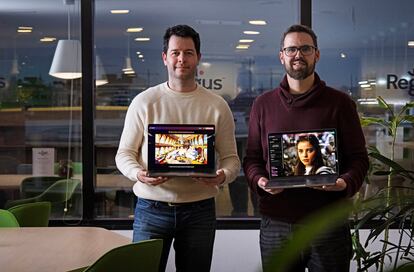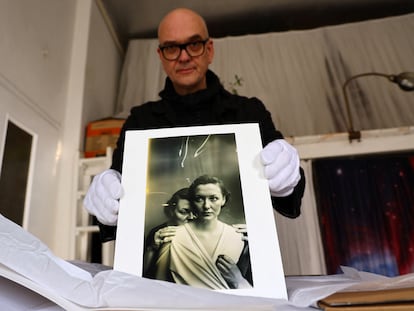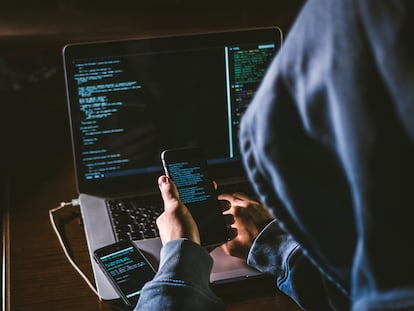How to make it big with the first ‘start-ups’ of the AI age: ‘A few years ago, just two people would not have been able to set this up’
Two entrepreneurs from Spain launched MagnificAI, an image enlargement app that hit the big leagues in just a month and a half with 400,000 registered users, attracting attention from Elon Musk, Hollywood and Beeple

When Sam Altman, co-founder of OpenAI, was in Madrid in May of last year, he said something that seemed like an exaggeration: “With artificial intelligence there will be $1 billion companies run by a single person.” His prophecy has not yet come true, but there are already mini start-ups that herald that future. For example, in Spain’s Murcia region.
On November 28, Javi López and Emilio Nicolás launched MagnificAI, an artificial intelligence application that allows users to improve image resolution and enhance images in a way and at a speed that was difficult to conceive until now. In just a month and a half they have racked up 400,000 registered users, of which a small percentage pays one out of three subscription options ranging from €37 to €275. They have attracted comments on X from Elon Musk and praise from the digital artist Beeple, author of one of the most expensive digital artworks in history.
This should not be possible 🤯
— Linus (●ᴗ●) (@LinusEkenstam) January 8, 2024
I've enhanced this 8x from 1.2MP to 77MP (10.752x7168px) using Magnific ai.
64x more pixels than the OG image.
You can do the same. Each super enhance takes 10-15 minutes and can run in the background.
A thread pic.twitter.com/AO0l51nCk3
This could be the story of any other startup, except it’s not. “A few years ago, just two people would not have been able to set up something like this,” says López, 42, in a video call from Murcia, where they work out of a local co-working space. “Now there are a series of advantages that AI gives you, which make an abysmal difference and make you go at the speed of light, and at the same time the world is so interconnected that anything can go viral overnight.”
López and Nicolás had three founding mantras that would not have been easy to maintain a few years ago: “Zero equipment, zero investment and not giving away the product for free,” says López. “How long are we going to want to extend that over time? We will extend the zero investment as long as we can, this is bootstrapping [a business term referring to starting out with very few resources] taken to death level. Equipment? Sooner or later it will be necessary. But big teams wear you out a lot. There are many people with many different types of problems and you take that home with you. Being in front of a computer with GPT-4 is more bearable,” he explains.
The speed at which their project went viral is also tied to the interest that generative AI has aroused. Its success lies not only in using tools that did not exist recently, but also in offering new services to many people eager to explore this technology. López explains: “Customers come from all over the world, only 5% are Spanish, and that is very noticeable in the revenue stream.” The businessman adds that, in addition, it has helped them “to have all the tailwind that AI represents and, within AI, generative AI, which not only has a tailwind, it is a hurricane that drives you forward. You spread the sails and you fly away.”
“Computer, enhance!”
— Elon Musk (@elonmusk) January 8, 2024
López explains what he felt when Elon Musk responded to him on X. “I’d tried many times to reach him through the comments, to see if I could catch his attention, but never did, and in this case I had not even written to him, but for some reason it appeared on his timeline and he made that well-known internet meme, which I believe comes from the days of Blade Runner. That also gave us another little push.” Beeple also wrote to him privately that he used the tool daily: “I think he now uses it in all his work, because I have already gotten used to identifying if something has been done with MagnificAI; I can already see certain patterns.” He cannot give away many details about their relationship with Hollywood, but it was there that he was shown the use of the technology in a film shot by “a hyper-famous actor and a hyper-mega-famous director,” he says.
Knowing that @beeple, one of the artists I admire the most, is using and enjoying Magnific in his artworks is a dream come true ❤️ pic.twitter.com/jbRKZIgUv2
— Javi Lopez ⛩️ (@javilopen) December 19, 2023
In 2008 López founded Erasmusu, an online community for international students, which he sold a few years later and ended up leaving in 2021. He then went on a sabbatical, staying busy with trips and other forms of entertainment. That is, until Dall-E 2, the second version of the OpenAI tool that creates images from text, came out in 2022. He saw that it was promising and he dedicated his spare time to it. He published his experiments and games with AI on his Twitter accounts in Spanish and English, where he cultivated a community interested in generative AI. “I was having a great time, I would have even paid to do what I did, which was to enjoy myself, experiment and play,” he says. Thanks to that kind of motivated relaxation, the idea for MagnificAI arose: “If I hadn’t had the time to play, I wouldn’t have found the key.”
In the summer of 2023 he spoke with Nicolás about his idea. But they didn’t get serious about it until October 2023. In just over a month, they had a product. They did not have many aspirations: “In our heads this was going to be temporary self-employment, a toy, a personal project, but it has exploded in a way we did not expect. I think it is really easy for many people, with current technologies, to assemble them. They’re like Lego pieces and suddenly you say ‘what a cool castle I’ve made,’” he says.
Street Fighter but all the characters are @elonmusk pic.twitter.com/ziF39qnGwa
— Javi Lopez ⛩️ (@javilopen) January 17, 2024
The feeling of being in a new era is perhaps hasty, but López has few doubts: “The impression of the last couple of years is that this seems like the year 2000 all over again, but instead of being 18 years old, in my case, and not having participated in that, now I am 42 and I have had the chance to experience it with a lot of free time.”
MagnificAI uses the open Stable Diffusion model. After running tests and tweaks, López saw that if he joined things, changed parameters or modified the source code, something would emerge that could become the seed of a new product. “We can’t comment much on those details, that’s the secret,” he adds.

The tool’s primary users are people who already work with images, from film production to illustrations and design, and need to improve the resolution of their final drafts. López explains: “Most people use it for the last mile. Imagine someone who comes from interior design architecture, has a render and doesn’t feel like spending hours fighting with lighting or textures. They run it through MagnificAI and give it a really polished look.” The idea is innovative enough to require a new name: “It’s a new business vertical which is reimaginative upscaling,” he says. AI helps “reimagine” the original image and enhance it with specific text requests.
Among the people who contact them, many of them have ideas about how the entrepreneurs could continue to grow. But it is not easy. At the moment, they still have work left to do to be able to apply MagnificAI to video or video games: “Some people tell us that if we had this for video we would be worth a billion bucks. But video is much more complex. Or that if we had it for real-time video games as the last layer, we would be worth two billion. I tell them sure, and if I had a flying car I would have antigravity,” he jokes.
Just as AI has been a great driver for López and Nicolás’s product, it is also a great driver for their hypothetical competitors: “We have competition, although I don’t think they do it at our level yet. On the other hand, we know that our defensive moat is not very wide, but we’re not freaking out over it. We are not scientists, we are not mathematicians. We realize that, sooner or later, the enlargement of images alone has its days numbered,” adds López.
Upscaled (a lot, 8x) pic.twitter.com/36bMWouIAY
— Javi Lopez ⛩️ (@javilopen) January 19, 2024
They are not ruling out the idea of selling the company and continuing to work within it, as they did with Erasmusu: “If it is purchased for economically decent terms by a company that values us and wants us to continue working on what we are doing, even on MagnificAI itself, then by all means. We don’t have an American mentality of waiting for this to be worth $3 billion in valuation rounds and having a team of 400 people,” he says.
López believes, deep down, that they will not be the only ones who have found this new path in the age of AI: “I think that in the next 10 years we will see single-person or single-person start-ups with fewer than five people, which amounts to almost the same, making $1 billion in revenue. And I don’t mean unicorns valued at $1 billion, but companies that actually make that amount.”
Sign up for our weekly newsletter to get more English-language news coverage from EL PAÍS USA Edition
Tu suscripción se está usando en otro dispositivo
¿Quieres añadir otro usuario a tu suscripción?
Si continúas leyendo en este dispositivo, no se podrá leer en el otro.
FlechaTu suscripción se está usando en otro dispositivo y solo puedes acceder a EL PAÍS desde un dispositivo a la vez.
Si quieres compartir tu cuenta, cambia tu suscripción a la modalidad Premium, así podrás añadir otro usuario. Cada uno accederá con su propia cuenta de email, lo que os permitirá personalizar vuestra experiencia en EL PAÍS.
¿Tienes una suscripción de empresa? Accede aquí para contratar más cuentas.
En el caso de no saber quién está usando tu cuenta, te recomendamos cambiar tu contraseña aquí.
Si decides continuar compartiendo tu cuenta, este mensaje se mostrará en tu dispositivo y en el de la otra persona que está usando tu cuenta de forma indefinida, afectando a tu experiencia de lectura. Puedes consultar aquí los términos y condiciones de la suscripción digital.
More information
Archived In
Últimas noticias
Not all insomnia is the same: Study identifies five subtypes and paves the way for personalized treatment
The United States designates Clan del Golfo as a foreign terrorist group
The United States strikes three more suspected drug boats, killing eight
The Iberian Peninsula is rotating clockwise, scientists report
Most viewed
- ‘El Limones’ and the growing union disguise of Mexican organized crime
- Christian Louboutin: ‘Young people don’t want to be like their parents. And if their parents wear sneakers, they’re going to look for something else’
- ‘We are dying’: Cuba sinks into a health crisis amid medicine shortages and misdiagnosis
- A mountaineer, accused of manslaughter for the death of his partner during a climb: He silenced his phone and refused a helicopter rescue
- The low-cost creative revolution: How technology is making art accessible to everyone











































